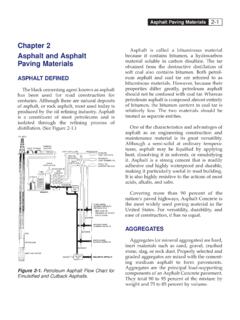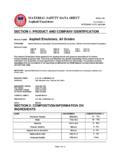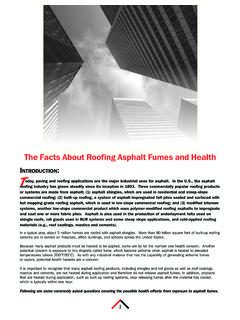Transcription of POLYMER MODIFIED ASPHALT - e-asfalto.com
1 POLYMER MODIFIED ASPHALTY vonne Becker, Maryro P. M ndez and Yajaira Rodr guezConsidering the international position of Venezuelanoil industry as one of the leaders of the current worldasphalt production, it is important to be aware of thesource of opportunities that POLYMER MODIFIED ASPHALT (PMA) offers in today s market. Based on that, this paperpresents an overview of the characteristics of POLYMER - ASPHALT binders, mostly used in the paving is being made on the relationships of composi-tion and formulation with the properties of the binder,and the relationships of the binder properties andperformance of the mixture. Although POLYMER modifi-cation seems to be the best solution to improve asphaltproperties, these systems present three main problems: a)poor ASPHALT POLYMER compatibility (which influences thestability of the system), b) higher viscosities during asphaltprocessing and application, and c) higher cost.
2 Theseissues are also covered in the present study, altogetherwith some field experiences. A summary of advantagesand disadvantages of most used polymers to modify asp-halt binders (styrene-butadiene-styrene (SBS), reclaimedtire rubber, polyethylene (PE), and atactic polypropylene(aPP)) is also el posicionamiento internacional quetiene la industria petrolera venezolana como uno delos l deres en la producci n actual de asfaltos a nivel mun-dial, es importante conocer la fuente de oportunidadesque ofrecen los asfaltos modificados con pol meros (PMAdel ingl s " POLYMER MODIFIED asphalts") en el mercadoactual. Con base en ello, se presenta en este estudio unavisi n de las caracter sticas de los asfaltos con pol mero,usados mayormente en la industria de la pavimentaci hace nfasis en las relaciones de la composici n y for-mulaci n con las propiedades del ligante y las relacionesde las propiedades del aglutinante y el comportamientode la mezcla.
3 Aun cuando la modificaci n con pol merosparece ser la mejor soluci n para mejorar las propiedadesdel asfalto, estos sistemas presentan tres inconvenientesprincipales, a saber: a) poca compatibilidad asfalto-pol -mero (lo cual afecta la estabilidad del sistema), b) viscosi-dades elevadas durante el procesamiento y aplicaci n delasfalto y c) altos costos. Estos aspectos tambi n son ana-lizados en este trabajo, indicando algunas experiencias decampo. Se incluye, adem s, un resumen de las ventajas ydesventajas de los pol meros m s usados para modificarasfaltos (estireno-butadieno-estireno (SBS del ingl s "sty-rene-butadiene-styrene"), caucho recuperado, polietileno(PE), y polipropileno at ctico (aPP)).Some improvements in ASPHALT properties have beenachieved by selecting the proper starting crude, ortailoring the refinery processes used to make asp-halt.
4 Unfortunately, there are only a few crudes that canproduce very good asphalts, and only a limited number ofactions that can be taken to control the refining process tomake improved next step taken by the industry was to modify the asp-halt. Air blowing makes ASPHALT harder. Fluxing agents ordiluent oils are some times used to soften the method that can significantly improve asphaltquality is the addition of polymers. This review will mainlydeal with the asphalts for road construction, since approxi-mately 85% of the ASPHALT goes to the pavement term " POLYMER " simply refers to very large moleculesmade by chemically reacting many small molecules (mono-mers) to produce long chains. The physical properties of aspecific POLYMER are determined by the sequence andchemical structure of the monomers from which it is made,its molecular weight and molecular weight polymers are added to ASPHALT , the properties of themodified ASPHALT cement depend on various things: POLYMER characteristics ASPHALT characteristics Mixing conditions Compatibility of POLYMER with in rutting resistance, thermal cracking, fati-gue damage, stripping, and temperature susceptibilityhave led POLYMER MODIFIED binders to be a substitute forasphalt in many paving and maintenance applications,including hot mix, cold mix, chip seals, hot and cold crackfil-ling, patching, recycling, and slurry seal.
5 They are usedwherever extra performance and durability are desired. Inmany cases, they are selected to reduce life cycle MODIFIED binders have allowed the use of pavingPDVSA-IntevepVISION TECNOLOGICA / VOL. 9 N 1, 2001 39 ARTICULO40 VISION TECNOLOGICA / VOL. 9 N 1, 2001techniques previously not viable, such as micro-surfacingand use of emulsion chip seals on high traffic are finding that many of the Superpave bindergrades (Superpave: SUperior PERformance PAVE ment),the final product of the Strategic Research HighwayProgram (SRHP), 1987-1992), need POLYMER modificationto concurrently meet the requirements for high tempera-ture rutting resistance and thermal cracking resistance atlow temperature. The United States, China, France and Italy are leaders inpolymer MODIFIED ASPHALT (PMA) research and develop-ment activities, even though considerable work has alsobeen done in Japan, Germany, Russia, Great Britain, main reasons to modify asphalts with polymers couldbe summarized as follows [1].
6 To obtain softer blends at low service temperatures andreduce cracking To reach stiffer blends at high temperatures and reducerutting To reduce viscosity at layout temperatures To increase the stability and the strength of mixtures To improve the abrasion resistance of blends To improve fatigue resistance of blends To improve oxidation and aging resistance To reduce structural thickness of pavements To reduce life costs of rheological behavior of ASPHALT - POLYMER blends is ofgreat interest because it is closely related to the perform-ance of pavements. Furthermore, the addition of smallamounts of POLYMER dramatically changes the rheologicalproperties of the ASPHALT . The addition of POLYMER intro-duces an additional difficulty to the ASPHALT complexity,because of its high molecular weight.
7 The formation of ahomogeneous system is not easy and incompatibilityproblems a MODIFIED binder consists of two distinct phases,three different cases must be considered for MODIFIED sys-tems [2]:Low POLYMER contentIn this case, the bitumen is the continuous phase of thesystem, and the POLYMER phase (less than 4%) is dispersedthrough it. Due to its lowered oil content, the bitumenphase has a correlatively higher asphaltene proportion. Asa result, both the cohesion and elasticity of the ASPHALT areenhanced. In addition, the POLYMER phase is dispersedthrough the bitumen matrix. At high service temperatures(around 60 C), the stiffness modulus of the POLYMER phaseis higher than that of the matrix. These reinforcingproperties of the POLYMER phase improve the mechanicalperformance of the binder.
8 At low temperatures, the stiff-ness modulus of the dispersed phase is lower than that ofthe matrix, and reduces its brittleness. Briefly, the dispers-ed POLYMER phase enhances the properties of the binderboth at low and at high service temperatures. In otherwords, the POLYMER extends the useful temperature rangefor the ASPHALT . In this case, the choice of bitumen is adetermining factor. These materials are usually employedfor content around 5%This system may show microstructures in which the twophases are continuous and interlocked. Such systems aregenerally difficult to control and pose stability problems( their micromorphology and properties often depend ontemperature history).Sufficiently high POLYMER contentMore than 7% in general, if the bitumen and POLYMER arecorrectly chosen.
9 The POLYMER phase is the matrix of thesystem. This is in fact not a bitumen, but a POLYMER plastif-ied by the oils in the bitumen in which the heavier fractionsof the initial ASPHALT cement are dispersed. In this case, thepolymer is the continuous phase and the ASPHALT is thereindispersed. The properties of such a system are fundament-ally different to those of a bitumen, and depend essentiallyon those of the POLYMER . One should speak not of a polymermodified bitumen, but of a thermoplastic adhesive. Thesematerials are usually employed for the last two years, USA is the country where mostof the research is done, followed by China, Canada andsome European countries (France, Italy, Great Britain andSpain). Among the companies that have been filing patentson PMA over the last two years, Marathon AshlandPetroleum LLC is the leading one.
10 The Goodyear Tire &Rubber Company, Fina Technology, Polyphalt LLC, BASFC orporation and Ergon Incorporated are also reported. There have been lots of movements in the marketing interest for PMA technology has been increasing, andso the number of companies which commercialize it, andtheir earnings. For example, Canada based Polyphalt,which develops and markets POLYMER MODIFIED asphaltreports its revenues (from royalties and license fees)increased 119 percent in the nine-month period ended onDecember 31, 2001 [3]. New PMA plants have also the most recent study (February, 2000) from theFreedonia Group on ASPHALT Products and Markets USdemands for ASPHALT products is forecasted to advancethree percent per annun through 2003, and so will do theadoption of the Superpave program s performance basedspecifications for road projects.





